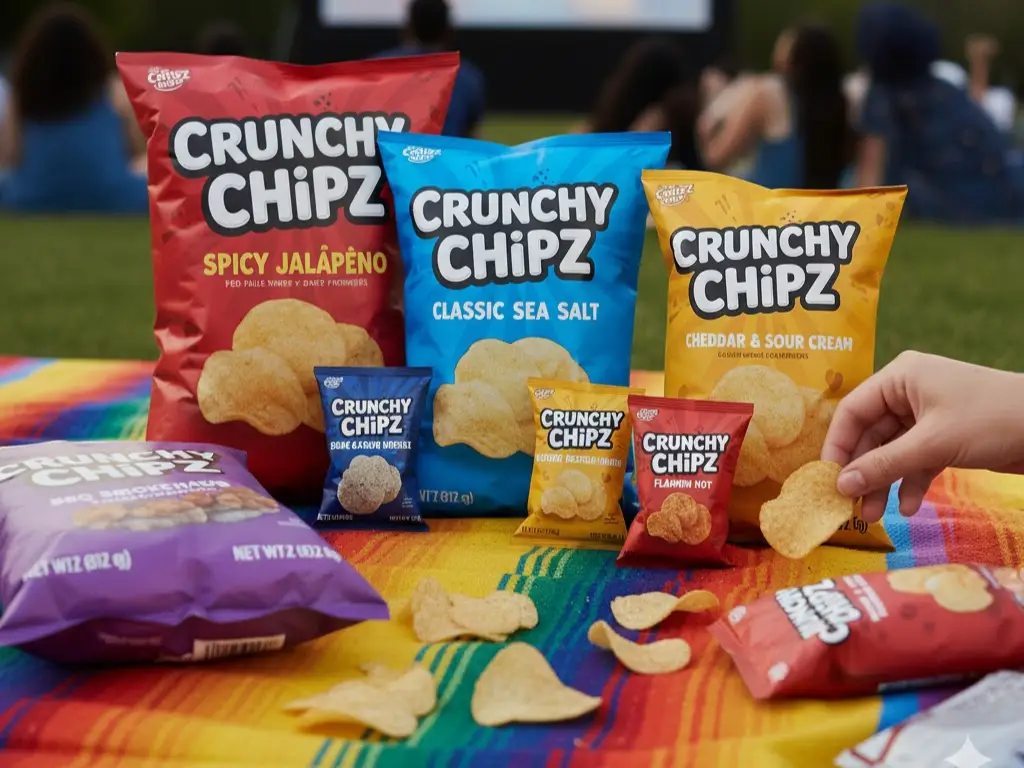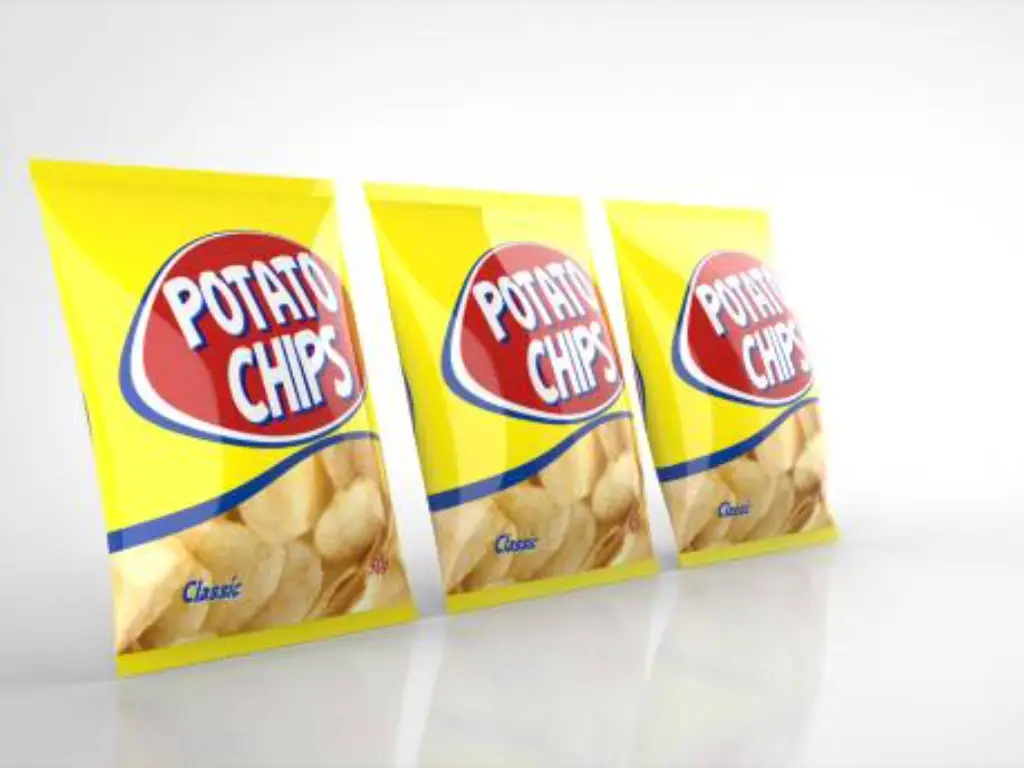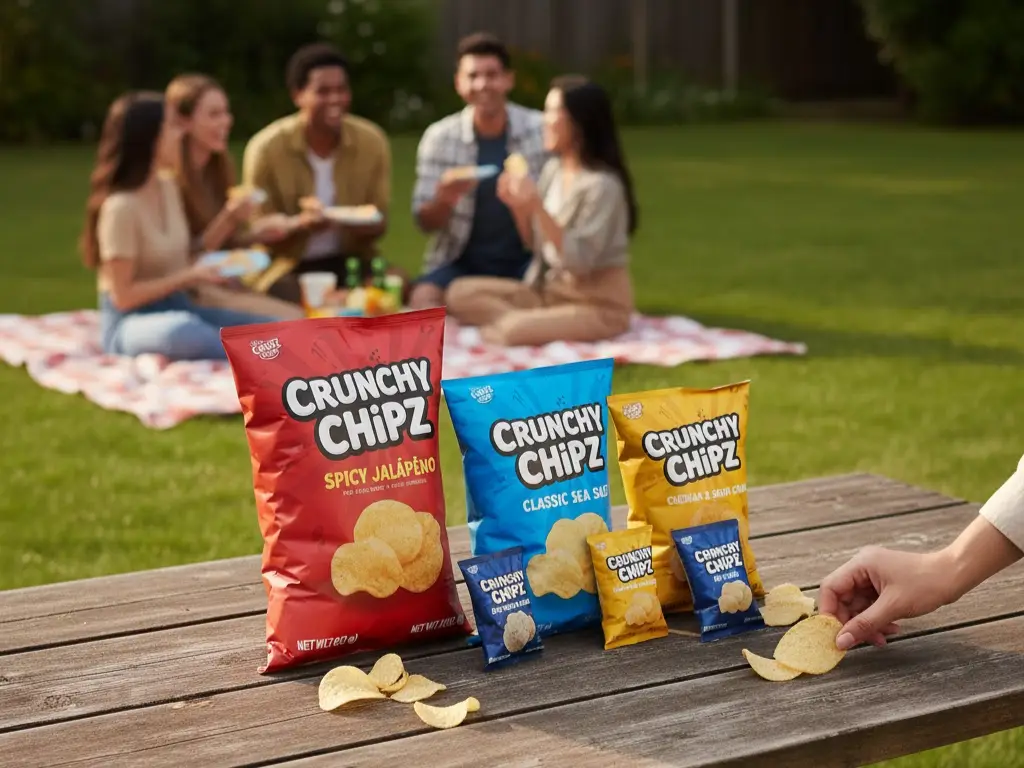Introduction
Buying a bag of chips might seem easy. However, once you start walking down the snack aisle, it will quickly become apparent that different bag sizes will complicate even the simplest of decisions. Ranging from single portion sizes to ‘party size’ bags, it can be difficult to gauge the most economical option.
A clearly defined chip bag size chart would greatly improve this scenario by allowing you to compare the different weights, prices, and intended purposes for the varying packaging sizes. Understanding the relationship between size, price, and consumption is critical, whether you are doing your shopping at a Walmart store or Walmart online.
This article offers a straightforward comparison of the most common chip bag sizes to help you match your purchase to your snacking requirements, decode your brand’s size labeling, and identify the better-value options that provide the most chips per dollar. Let’s examine what the different sizes really provide.
Overview of Standard Chip Bag Sizes
In the quest for the perfect snack, shoppers often prioritize the chip brand or flavor, and they often neglect the bag’s size and its implications for the value, convenience, and fit for different settings. If chips will be used for daily snacking, family gatherings, or will be kept in bulk, it can be helpful to know the standard chip bag sizes. This is to ensure you make more efficient purchases. A chip bag size chart can help you assess the weight and price of the bag to decide the most suitable option based on your snacking needs.
- ● Personal or Single-Serve (1–2 oz / 28–57 g)
The Personal or Single-Serve size is the most compact format, typically ranging from 1 to 2 ounces. These bags are designed for maximum convenience. They fit perfectly in lunchboxes, and for quick snack breaks, and are often encountered in vending machines and on retailers’ checkout lanes. They are most readily available in Walmart stores. Despite their usefulness, they carry the highest cost per ounce, making them the least economical in most chip bag sizes in chart comparisons. Still, they’re excellent for managing portion size or sampling special flavors without committing to a full bag of chips. For controlled consumption and portability, this format remains a practical, if slightly expensive choice.
- ● Regular or Standard Size (7–10 oz / 198–283 g)
The standard size is the most commonly purchased format, serving as the default for most chip size bags. This size offers a good balance between value and quantity and is cost-efficient compared to single-serve bags. This is also a great size for smaller households. They are easily portable, can be resealed, and frequently contain several servings. This format for potato and corn chips and cheese puffs offers enough variety and is less likely to overwhelm your cabinets or your appetite. This size is ideal for grazing.
- ● Family Size (9–10.5 oz / 255–298 g)

The family size bag goes the extra mile by adding a few extra ounces to the regular format. This makes it a more fitting group snack or more for regular consumption. Usually just under 300 grams, this size offers a more economical price for value, thus earning a more valuable rating on most chip bag size charts. It is a solid option for small families or couples who don’t mind the extra volume, enjoy snacking together. Although it is still fairly easy to store, the bigger the bag, the more attention must be paid to keeping the bag’s internal climate after it has been opened. This is especially true if it is going to be left open for a few days.
- ● Party or Mega Size (13–16 oz / 368–453 g)
The party size, or “mega size” as it’s sometimes called, is geared towards social occasions. These bags, ranging from 13 to 16 ounces, are perfect for family gatherings, game nights, or office kitchens, and are great for communal situations. The cost per ounce is very good, and the large size often has seasonal or special flavors that are meant to promote trial purchases. If you’re reviewing a chip bag size chart and need to shop for a quantity to last over a period, this one is fantastic. Just remember that bigger bags tend to encourage bigger appetites, and portion control will be a little more difficult.
- ● Extra-Large or Bulk (20–30 oz / 566–850 g)
The extra-large or bulk size, which can be found at warehouse clubs or online marketplaces, is at the top of the scale. This size can vary from 20 to 30 ounces, but you won’t often see these sizes at your everyday Walmart. It is designed for large families, gatherings, or frequent snackers who want to maximize their savings. It is worth noting how much value this size offers, as it is the most economical option on any size chart for chip bags. This size does require proper storage, and bags may come with resealable openings to protect unused contents. These bags are also filled with food-grade nitrogen to keep the texture of the chips during transport and storage. This size is great for high-volume consumers and is perfect for those with the appetite and the space to match.
Standard Chip Bag Sizes Chart for Different Brands
In the United States, most major retailers like Walmart, Target, and Amazon offer the most popular snack brands with chip bags of various sizes. These brands usually have small differences and variations in size, weight, and portions. The listings example common regular size and party size offerings:
- ● Regular Size Chip Bags Chart
| Chips Brand | Weight (oz) | Weight (g) | Approx. Number of Chips |
| Lay’s Classic Potato Chips | 8 oz | 226.8 g | ~150 |
| Ruffles Original | 8.5 oz | 241 g | ~120 |
| Doritos Nacho Cheese | 9.25 oz | 262 g | ~180 |
| Cape Cod Kettle Cooked | 7 oz | 198 g | ~60 |
| Miss Vickie’s Sea Salt | 7 oz | 198 g | ~80 |
| Herr’s Classic | 7.75 oz | 219 g | ~100 |
| Wise Original | 7.5 oz | 213 g | ~110 |
| SunChips Original | 7 oz | 198 g | ~100 |
| Terra Vegetable Chips | 6.8 oz | 193 g | ~120 |
- ● Party Size Chip Bags Chart
| Chips Brand | Weight (oz) | Weight (g) | Approx. Number of Chips |
| Lay’s Classic | 15.75 oz | 447 g | ~450–500 |
| Ruffles Original | 13 oz | 369 g | ~150 |
| Doritos Nacho Cheese | 15 oz | 425 g | ~350–400 |
| Cape Cod Kettle Cooked | 14 oz | 397 g | ~400–450 |
| Miss Vickie’s Sea Salt | 13 oz | 369 g | ~180 |
| Herr’s Classic | 14 oz | 397 g | ~180 |
| Wise Original | 15 oz | 425 g | ~230 |
| SunChips | 13 oz | 369 g | ~100 |
| Terra Vegetable Chips | 15 oz | 425 g | ~260 |
Note: Information is compiled from primary brand packaging and leading U.S. retailer websites like Walmart, Target, and Amazon. The estimated chip count is based on consumer reports and varies based on flavor, thickness, and chip cutting regulation. Chip bags have nitrogen gas, so slight gross volume differences.
Why Chip Bag Sizes Differ by Brand
Different brands have different sizes in their chip packets for a few reasons. They look at their package design, the way the products are arranged, and the way the products are sold. For example, a brand that labels a packet as “family size” may have a size that appears almost the same as a “regular size” packet from a different brand. An issue can come from this, as consumers may try to determine value just from a visual comparison. The inconsistent sizes across brands show the importance of having a standard chip bag size to check the actual value and cost efficiency.
One important aspect of why customers think the volume of bags varies so greatly is the air, or nitrogen gas, in the bags. Some customers might think this is a deceitful marketing ploy, but in reality, nitrogen is used to help make the chips stay fresh and to protect the chips from breakage during transport. Yet, the nitrogen gas might take up differing amounts of space, making the bag look like it is fuller or emptier when opened.
Brand strategy is just as important as the technical elements of packaging. For example, convenience is a value that some companies accommodate by designing small bags that are easy to pack for kids’ lunches or for snack portions. On the other end of the convenience spectrum, some companies focus on premium positioning by offering special, limited, or flavored chips that are presented in aesthetically pleasing packaging. Although such limited premium packaging may contain fewer chips than the other bags, it is marketed at a premium price. The price, along with the packaging, is likely created to match the target demographic.
These variables make it challenging to rely solely on visual size. It is optimal for consumers to look at the net weight, listed in ounces, and compare the unit price, if available. Referring to chip bag size charts allows consumers to counter the branding inconsistencies by making value assessments based on the dimensions of the bag, other than the packaging or visual perception.

How Chip Bag Sizes Impact Logistics
Chip packaging is about consumer appeal, but it directly affects how well products move through the supply chain. From transport to shelf placement, chip bag sizes impact cost, storage, and the environmental impact. An optimal packaging bag provides protection, presentation, and meets logistical requirements.
- ● Volume and Transport Efficiency
Larger chip bags take up space disproportionate to their weight due to nitrogen cushioning. It is needed to avoid breakage, but the added volume negatively impacts transport efficiency. Smaller bags result in excess packaging waste, while large bags result in reduced shipping density. Brands need to balance protection and volume to optimize fuel consumption and shipping costs.
- ● Packaging Design and Warehouse Optimization
The design of bags for a warehouse needs to have a standard size for stacking and automated sorting. Bags that have irregular sizes create inefficiencies in storage and disrupt pallet layouts. Bag sizes that are optimized enhance handling, use of bags, and turnover of bags in the inventory. Packaging that corresponds to standard logistics processes will facilitate easier movement in the distribution chain for retailers and suppliers.
- ● Retail Display and Shelf Management
Shelf space in stores such as Walmart is limited and meticulously planned. Larger sizes chip bags take up too much space and reduce the number of bags that can be displayed, while smaller bags may be too far to see. Retailer planograms dictate the optimal position for certain sizes. This is to say that delivery of self-serve displays can be improved with user accommodation and brand appeal maintained.
- ● Supply Chain Strategy and Sustainability
Oversized packaging adds to the emission of greenhouse gases and increases the use of materials. Using smaller chip bags enables better load planning, which also reduces the environmental impact. Control over the supply chain is optimized with unsized chip bag pricing as a strategic lever. Responsible operations also promote sustainability to provide a positive brand image.
Baishen’s Flexible Packaging Solutions for Every Chip Bag Size
Chip bag sizes impact everything from shelf appeal to the efficiency of transportation. However, arriving at the ideal size, one that is congruent to the brand’s objectives, offers product safety, and facilitates the logistical functions, is not going to be captured by guesswork alone. You will need a packaging partner.
Baishen Pack is a global manufacturer and a provider of custom flexible packaging solutions for a variety of product lines, including food, snacks, beverages, and pet food. No matter the product line you are launching, whether it be a 1-oz single-serve pouch, a 10-oz bag with a resealable zipper, or a 30-oz bulk format needing high-barrier protection, Baishen will supply high consistency and flexibility across all scales of production.
Along with high-performance films, functional designs like tear notches and transparent windows, and shelf-ready matte, glossy, and metallic surfaces, we provide all the necessary components for packaging. In harmony with the sales channel, which may be retail, ecommerce, or wholesale, we incorporate custom sizing, pouch configurations, and print design to achieve the desired outcome.
Whether your chip product needs packaging that protects, transports, and makes an impact on the shelf, Baishen Pack is customized to your growth needs, balancing functionality and aesthetics.
How to Choose the Right Chip Bag Size Oz
Choosing the right chip bag size is more than estimating your hunger. Think about your consumption, storage, and target price. Chips can be bought for personal consumption, for families, and for events. Each option aims to minimize value loss and unnecessary waste.
- ● Assess the Usage Scenario
First, you need to figure out how the product is going to be consumed. Is it for personal snacking, for a family, or for a large crowd? If you just need something to snack on, single-serve bags are handy. For group settings, family-size or party-size bags are more appropriate. This way, the size of the packaging matches your consumption needs.
- ● Compare Weight and Unit Cost
Helpful chip bag sizes can assist in checking contents’ net weight, usually listed in ounces, across various pack sizes. After determining the total weight, it is important to compute the price per ounce, or ounce, to fully appreciate the economic worth. Sometimes, a larger pack is worth it, but it is only true if you can store the contents long enough to avoid spoilage.
- ● Consider Storage and Resealability
Most people forget about storage. Sometimes, extra-large chip bags may be hard to place in the kitchen, in the store, or even to organize. Resealability is crucial if the product is not all consumed in one sitting. Zippers or other enclosure features help keep the pack fresh and useful, which is especially important in regular-sized and bulk bags.
- ● Factor in Eating Habits
Eating behavior is another factor to consider. For people who snack mindlessly, smaller bags help to control portions and reduce the risk of overconsumption. For people who are aware of their daily caloric intake, balance and enjoyment can be achieved without excess food intake.

FAQs about Chip Bag Sizes
- ● What are the dimensions of a regular chip bag?
The size of a typical chip bag is approximately 9 x 12 inches (23 x 30 cm), but the size depends on the brand, chip thickness, and the packaging design. The height, width, and gusset of the bag are modified by manufacturers to fit the size of the products, protection levels, and where the product is displayed in the store.
- ● Are chip bag sizes different in other countries?
Yes. The size of the chip bags varies in different markets depending on local laws, culture, and the quality of service being served. Smaller portions and metric labeling (grams) are used in Europe, whereas the North American market would prefer bigger oz bags and bulk packs to serve the family or party.
- ● How big is a 10 oz bag of chips?
A 10-ounce (283g) chip bag is typically a regular or a family-size package. It has a sufficient number of chips to serve three or five individuals, depending on the size of the portion. This is a convenient, affordable, and storage-efficient format that is one of the most widespread retail formats.
- ● How big is a 3 oz bag of chips?
Size-wise, a 3 oz (85 g) bag is in the middle of the range. It is larger than a single-serve bag, but it is also smaller than a standard retail bag. It also provides one to two servings. For portion control and on-the-go snacking, it is the perfect size.
- ● Why do chip bags sound loud when opened?
This is due to the unique sound that is the result of the multi-layer film structure, which encloses the chips to keep them fresh. The nitrogen in the bag flies out quickly when you open the bag, making a popping noise. The materials are also deliberately made airtight and puncture-proof to protect the products.
- ● Why do chip bags have so much air?
The nitrogen gas in the air within is, in fact, a defenseless covering of chips against fractures and oxidation. The gas avoids softening of the product and shelf life. The chips are also cushioned by the space, thus reducing the damage before the product reaches the retailers.
The majority of the chip bags are composed of composite materials like plastic and metalized films that are hard to recycle using the ordinary municipal application. Nevertheless, some manufacturers currently provide recyclable or compostable packaging materials to help in sustainability objectives as well as waste reduction.
- ● Are Potato Chips healthy?
Potato chips are very high in fat, sodium, and calories, and it is therefore recommended to consume them in moderation. Healthier choices are to use baked or air-fried chips that have less oil in them. Whatever the type, good packaging ensures the preservation of freshness and flavor, which is good quality of the product up to consumption.
Conclusion
Choosing the right chip bag size is more than a matter of personal preference—it’s a strategic decision that influences cost efficiency, consumption habits, and even product longevity. By understanding the differences between formats and referencing a reliable chip bag sizes chart, consumers and manufacturers alike can make informed decisions that align with practical needs and market expectations.
Each packaging size serves a unique purpose. From portion-controlled small bags to value-driven bulk formats, identifying the size that fits your lifestyle or product line ensures better use of resources and enhanced user satisfaction. For brands, thoughtful packaging selection also supports stronger shelf presence and improved supply chain performance.
Ultimately, size is a key variable in both snacking and packaging strategy. Whether you’re planning a product launch or simply making your next grocery decision, aligning chip bag dimensions with context and usage is essential to delivering value, freshness, and convenience—at every level of the experience.

